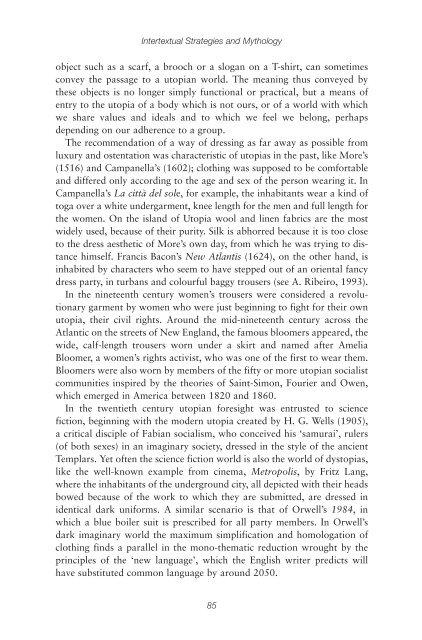Create successful ePaper yourself
Turn your PDF publications into a flip-book with our unique Google optimized e-Paper software.
Intertextual Strategies and Mythology<br />
object such as a scarf, a brooch or a slogan on a T-shirt, can sometimes<br />
convey the passage to a utopian world. <strong>The</strong> meaning thus conveyed by<br />
these objects is no longer simply functional or practical, but a means of<br />
entry to the utopia of a body which is not ours, or of a world with which<br />
we share values and ideals and to which we feel we belong, perhaps<br />
depending on our adherence to a group.<br />
<strong>The</strong> recommendation of a way of dressing as far away as possible from<br />
luxury and ostentation was characteristic of utopias in the past, like More’s<br />
(1516) and Campanella’s (1602); clothing was supposed to be comfortable<br />
and differed only according to the age and sex of the person wearing it. In<br />
Campanella’s La città del sole, for example, the inhabitants wear a kind of<br />
toga over a white undergarment, knee length for the men and full length for<br />
the women. On the island of Utopia wool and linen fabrics are the most<br />
widely used, because of their purity. Silk is abhorred because it is too close<br />
to the dress aesthetic of More’s own day, from which he was trying to distance<br />
himself. Francis Bacon’s New Atlantis (1624), on the other hand, is<br />
inhabited by characters who seem to have stepped out of an oriental fancy<br />
dress party, in turbans and colourful baggy trousers (see A. Ribeiro, 1993).<br />
In the nineteenth century women’s trousers were considered a revolutionary<br />
garment by women who were just beginning to fight for their own<br />
utopia, their civil rights. Around the mid-nineteenth century across the<br />
Atlantic on the streets of New England, the famous bloomers appeared, the<br />
wide, calf-length trousers worn under a skirt and named after Amelia<br />
Bloomer, a women’s rights activist, who was one of the first to wear them.<br />
Bloomers were also worn by members of the fifty or more utopian socialist<br />
communities inspired by the theories of Saint-Simon, Fourier and Owen,<br />
which emerged in America between 1820 and 1860.<br />
In the twentieth century utopian foresight was entrusted to science<br />
fiction, beginning with the modern utopia created by H. G. Wells (1905),<br />
a critical disciple of Fabian socialism, who conceived his ‘samurai’, rulers<br />
(of both sexes) in an imaginary society, dressed in the style of the ancient<br />
Templars. Yet often the science fiction world is also the world of dystopias,<br />
like the well-known example from cinema, Metropolis, by Fritz Lang,<br />
where the inhabitants of the underground city, all depicted with their heads<br />
bowed because of the work to which they are submitted, are dressed in<br />
identical dark uniforms. A similar scenario is that of Orwell’s 1984, in<br />
which a blue boiler suit is prescribed for all party members. In Orwell’s<br />
dark imaginary world the maximum simplification and homologation of<br />
clothing finds a parallel in the mono-thematic reduction wrought by the<br />
principles of the ‘new language’, which the English writer predicts will<br />
have substituted common language by around 2050.<br />
85

















